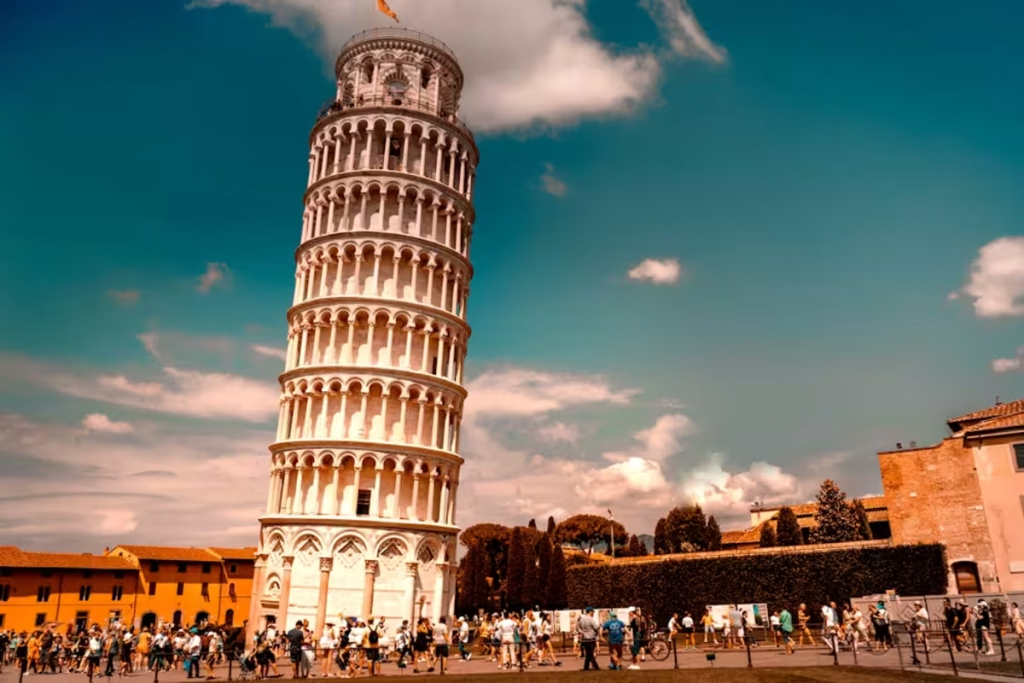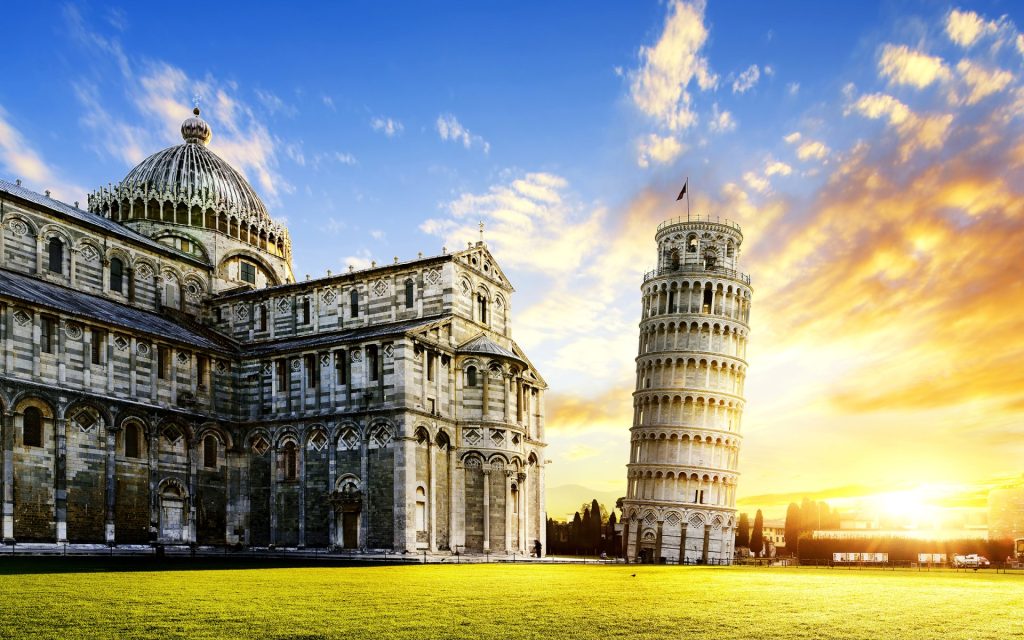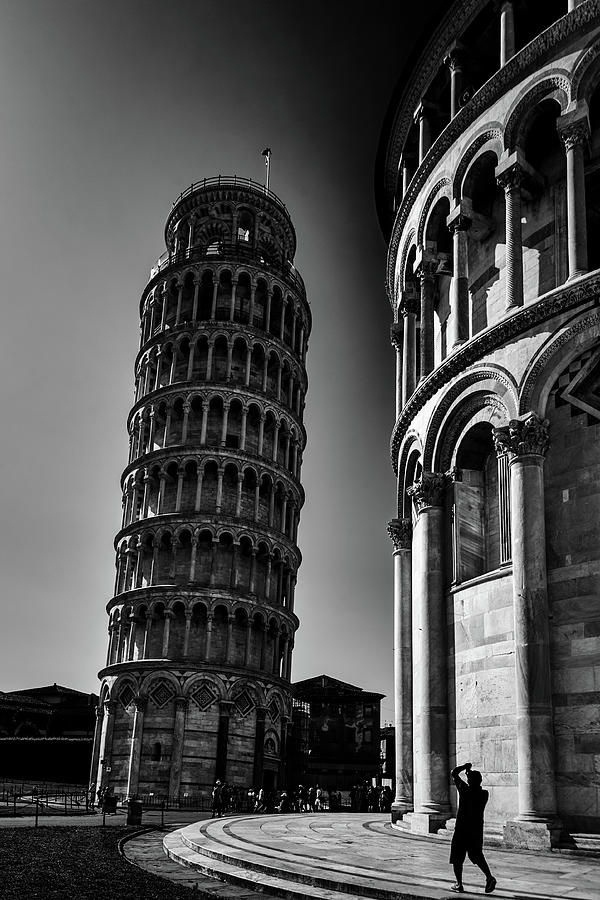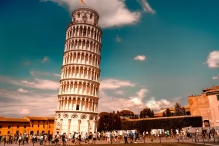The Leaning Tower of Pisa: An Architectural Marvel and Historical Icon

The Leaning Tower of Pisa: An Architectural Marvel and Historical Icon
The Leaning Tower of Pisa, known in Italian as “Torre Pendente di Pisa,” is one of the most recognizable and intriguing landmarks in the world. Located in the city of Pisa, in the Tuscany region of Italy, this freestanding bell tower is famous not only for its unintended tilt but also for its remarkable architectural beauty and historical significance. This comprehensive article explores the history, construction, architectural features, and cultural impact of the Leaning Tower of Pisa.

Historical Background
The construction of the Leaning Tower of Pisa began in August 1173 during a period of prosperity and military success for the Republic of Pisa. The tower was intended to be the freestanding bell tower for the cathedral of Pisa, forming part of a grand religious complex known as the Piazza dei Miracoli (Square of Miracles). This square also includes the Pisa Cathedral, the Baptistery, and the Camposanto Monumentale (monumental cemetery).
The tower’s initial design is attributed to Bonanno Pisano, although there is some debate among historians about the true identity of the architect. Construction proceeded smoothly for the first three stories until 1178 when the soft ground on one side of the tower began to settle, causing it to lean. This foundational instability halted construction for nearly a century as Pisa’s engineers and architects grappled with the issue.
Construction and Engineering Challenges
Construction resumed in 1272 under the direction of Giovanni di Simone, who attempted to compensate for the tilt by building the upper floors with one side taller than the other. This adjustment created a slight curve in the tower’s structure. However, the project faced further interruptions due to ongoing wars and political unrest, delaying its completion until the mid-14th century.
The tower stands at approximately 56 meters (183 feet) tall and weighs about 14,500 metric tons. It consists of eight stories, including the chamber for the seven bells, each representing a musical note. The tilt, which initially measured about 5.5 degrees, continued to increase over the centuries, posing a significant threat to the tower’s stability and safety.

Architectural Features
The Leaning Tower of Pisa is a masterpiece of medieval architecture, featuring a blend of Romanesque and Gothic styles. Its exterior is adorned with blind arcades, marble columns, and intricate carvings, showcasing the artistic and engineering prowess of the period.
The Base and Foundation: The foundation of the tower is only three meters deep, set in a substrate of weak, unstable subsoil. This insufficient foundation is the primary reason for the tower’s tilt. Efforts to stabilize the structure have been ongoing since the initial construction phase.
The Bell Chamber: The topmost eighth story houses the bell chamber, where the seven bells are located. The largest bell, known as “L’Assunta,” was installed in 1655. The bell chamber is an open loggia, allowing the sound to travel across the city of Pisa.
Columns and Arches: Each of the tower’s stories features a series of open galleries with columns and arches. The columns are made of white and grey marble, creating a striking visual contrast. The arcades add to the tower’s aesthetic appeal and structural complexity.
Interior Staircase: Inside the tower, a spiral staircase with 294 steps winds its way up to the bell chamber. Climbing these stairs offers a unique experience, with the tilt becoming more pronounced as one ascends.
Efforts to Stabilize the Tower
Over the centuries, numerous efforts have been made to stabilize the Leaning Tower of Pisa and prevent its collapse. Early attempts included adding counterweights and various structural reinforcements. However, it wasn’t until the late 20th century that a comprehensive solution was implemented.
In 1990, the tower was closed to the public for safety reasons, and a major stabilization project commenced. Engineers used a combination of soil extraction, counterweights, and steel cables to gradually reduce the tilt. By 2001, the tilt had been reduced to about 3.97 degrees, and the tower was declared stable for at least another 200 years. The success of this project allowed the tower to reopen to the public, much to the delight of tourists worldwide.

Cultural and Touristic Significance
The Leaning Tower of Pisa has become a global icon and a major tourist attraction, drawing millions of visitors each year. Its unique tilt and historical context make it a symbol of resilience and ingenuity. The tower’s popularity is further enhanced by its location within the Piazza dei Miracoli, a UNESCO World Heritage Site since 1987.
Photographic Appeal: The tower’s distinctive tilt makes it a favorite subject for photographers. Visitors often engage in creative photography, posing as if they are holding up or pushing down the tower. These playful images have become a quintessential part of the Pisa experience.
Educational Value: The Leaning Tower of Pisa offers valuable insights into medieval engineering, architecture, and the challenges of constructing large structures on unstable ground. The efforts to stabilize the tower also provide lessons in modern engineering techniques and preservation methods.
Cultural Impact: The tower has inspired numerous cultural references, appearing in literature, film, and art. It symbolizes human perseverance in the face of challenges and has become a metaphor for overcoming obstacles.
Visiting the Leaning Tower of Pisa
For those planning to visit the Leaning Tower of Pisa, here are some practical tips and recommendations to enhance your experience:
Tickets and Timing: It is advisable to book tickets in advance, especially during peak tourist seasons, to avoid long lines. Visitors can choose from various ticket options that include access to the tower, the cathedral, the Baptistery, and the Camposanto. Early morning or late afternoon visits are ideal for avoiding crowds and enjoying the site in a more relaxed atmosphere.
Climbing the Tower: Climbing the 294 steps to the top of the tower is a must-do activity for many visitors. The experience offers unique perspectives on the tower’s tilt and provides stunning views of Pisa and the surrounding Tuscan landscape. Be prepared for a slightly disorienting sensation due to the lean, and take your time ascending the narrow staircase.
Exploring the Piazza dei Miracoli: In addition to the Leaning Tower, the Piazza dei Miracoli is home to other significant landmarks, including the Pisa Cathedral, the Baptistery, and the Camposanto Monumentale. Each of these sites offers its own historical and architectural treasures. The cathedral, with its impressive façade and interior, is a masterpiece of Romanesque architecture. The Baptistery, known for its acoustics and unique blend of Romanesque and Gothic styles, is also worth a visit.
Guided Tours and Audio Guides: To gain a deeper understanding of the history and significance of the Leaning Tower and the surrounding complex, consider joining a guided tour or using an audio guide. These resources provide detailed information about the construction, challenges, and restoration efforts, enriching your visit.
Local Cuisine and Souvenirs: After exploring the tower and the Piazza dei Miracoli, take some time to enjoy the local cuisine. Pisa offers a variety of Tuscan dishes, including pasta, seafood, and traditional desserts. There are also numerous shops and stalls selling souvenirs, from miniature replicas of the Leaning Tower to local crafts and products.

Conclusion
The Leaning Tower of Pisa is not just an architectural curiosity but a testament to the ingenuity and perseverance of human beings. Its unique tilt, resulting from centuries-old engineering challenges, has turned what could have been a disastrous flaw into a world-renowned feature. The tower’s historical significance, architectural beauty, and the successful efforts to stabilize it make it a symbol of resilience and innovation.
As you stand before the Leaning Tower, marvel at its graceful lean and reflect on the countless individuals who have worked to preserve this iconic structure. Whether you are a history buff, an architecture enthusiast, or simply a curious traveler, the Leaning Tower of Pisa offers an unforgettable experience that connects you to a rich tapestry of human achievement and ingenuity.
By visiting this remarkable landmark, you become part of a centuries-old story that continues to captivate and inspire. The Leaning Tower of Pisa stands as a reminder that even in the face of challenges, beauty and greatness can emerge, leaving an enduring legacy for future generations.
Cryptocurrency airdrop theforex24 Aypa Group website design تحصیل در ایتالیا دانشگاه های ایتالیا تحصیل رایگان در ایتالیا پذیرش تحصیلی در ایتالیا




